| 
| | |  | Travel
Tim Boxer | Nina Boxer | 
| | | 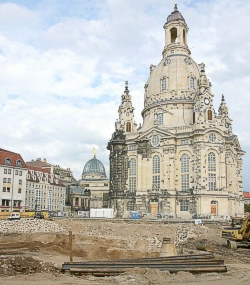
Restoring a city’s splendor
Photos by Tim Boxer | Dresden Reborn 
N the last days of the war, February 13, 1945, RAF and American planes littered the blue sky over Dresden and dropped payloads of frightening destruction. The firestorm left one of Europe’s most outstanding baroque cities in ruins with a death toll of 25,000. Dresden was one of Germany’s magnificent jewels, called the Florence of the Elbe for its art treasures, architecture and cultural heritage. Since the demise of the Communist government, Dresden has recovered miraculously. The city’s been rebuilt and renewed to its former glory. The people are now ready for their 15 minutes. They will celebrate its 800th anniversary starting on March 31, 2006. For information on touring Dresden visit www.dresden-info.fhg.de. |
| 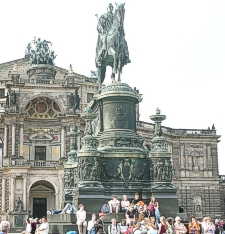
Semperoper | Semperoper 
HE Semperoper, the outstanding Saxony State Opera House, is where we enjoyed Gustav Mahler’s Symphony No. 10 directed by British conductor Daniel Harding. Semperoper, built in 1871-78 by Gottfried Semper, is one of the city’s most impressive historic landmarks. It is located in Theaterplatz, a beautiful square. It was in Dresden where Richard Wagner conducted the premiere of Tannhauser and other works. |
| | Frauenkirche 
FTER 60 years, much of it spent in neglect under the East German communist regime (GDR), Dresden has rebounded since Germany’s 1989 reunification. One symbol that stands out for peaceful reconciliation is the Frauenkirche, or Church of Our Lady, which has been resurrected on Neumarkt Square. It has become a bridge of harmony between Great Britain, America and Saxony. In 1994 the British established the Dresden Trust, and Americans founded the Friends of Dresden, Inc., to reconstruct the blackened ruins of the church as a gesture of reconciliation. Information: www.frauenkirche-dresden.org. Built in 1726-43, Frauenkirche was renowned as a masterpiece of baroque architecture and a significant symbol of German Protestantism. It’s no wonder that it was built in Saxony, as this was the first state in which the Reformation took hold. Progress on the reconstruction of the church is almost complete. The church will be consecrated on October 30. The Frauenkirche will be completely resuscitated in time for the celebration of Dresden’s 800th birthday next year. |
| | 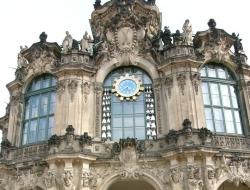
Glockenspiel with 40 bells of Miessen china
at Zwinger Palace.
| Zwinger 
HE mighty Dresdner Zwinger, modeled after Versailles, was built by Augustus the Strong, elector of Saxony and king of Poland, in 1710-32. It stands as a remarkable example of European baroque. Zwinger means outer bailey, due to its location on the former city fortifications. This impressive complex is made up of an abundance of sculptures, waterworks, pavilions, orangeries and, especially, the interior court, all of which make for an amazing palace. 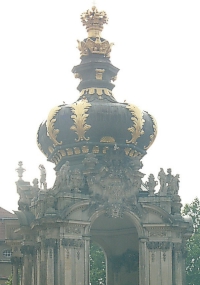
Zwinger crown | Here you will see the Old Masters Art Gallery with exquisite showpieces such as Raphael’s Sistine Madonna, the Armory (Rustkammer) with an amazing assortment of weaponry from 15th to 18th centuries, the Bath of Nymphs, and a display of handcrafted life-size animals. Also the world’s largest porcelain collection, some 50,000 unique pieces from Japan and China, as well as historic Meissen porcelain, sometimes known as Dresden china. |
| 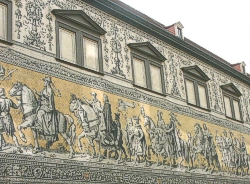
Procession of Princes | City Scene 
AKE a stroll on Augustus-strasse and you will come upon the world’s largest porcelain frieze. Along the 102-meters of a wall is the Furstenzug, or Procession of Princes. This long mural, made of 25,000 tiles of Meissen china, was created in 1907 and depicts the rulers of Saxony from 1123 to 1904. |
| | 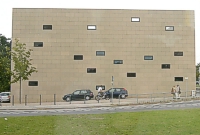
The synagogue
| 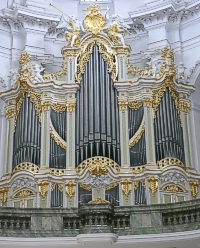
Catholic cathedral organ | Temples of Faith  OTTFRIED SEMPER also built the grand synagogue in 1838. The Nazis destroyed it on Kristallnacht of Nov. 9, 1938. The new synagogue was inaugurated on Nov. 9, 2001. OTTFRIED SEMPER also built the grand synagogue in 1838. The Nazis destroyed it on Kristallnacht of Nov. 9, 1938. The new synagogue was inaugurated on Nov. 9, 2001.
|
| | 
Streetcar
| 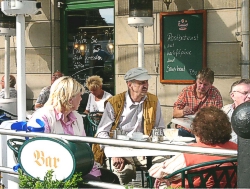
Outdoor restaurant | Bulow Residenz 
HERE is no contest when it comes to choosing where to rest your head. The Relais & Chateau Hotel Bulow Residenz is a grand hotel, originally built in 1730 and refurnished in1993, making it one of the oldest Baroque manor houses in Saxony. The 25 rooms and 5 suites are spacious and modern with all the luxury amenities. The dining room seats 50 in an elegant and comfortable atmosphere. In the basement the intimate Caroussel Bar seats 20, and attracts locals as well as guests. The hotel attracts an international clientele. Every employee speaks English. In fact, the hotel exchanges service staff with Relais & Chateau Hotels in England. If you seek intimacy and individuality, this is your choice. www.Buelow-Residenz.de. |
| | [ Back to Top ]
| | |